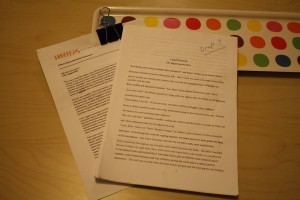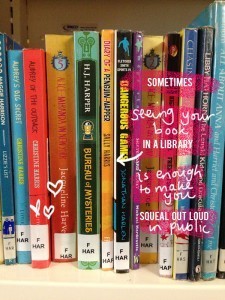Sally Harris's Blog, page 4
September 24, 2013
Why you need to get yourself some beta readers
NOTE: the images in this feed have been downsized or removed for copyright reasons. To see them in their unmodified state, please view the original post by clicking here.
So, last week, I wrote a post explaining the benefits of using a manuscript assessment service as one of your first steps to publication after finishing your manuscript. Today, I want to talk about the next step that I take: beta readers.

In a nutshell, beta readers are critical friends who are willing to cast an eye over your manuscript and are able to give you some feedback or a critique of your piece. After my piece has come back from the manuscript assessor and I’ve fixed all of the holes that they have pointed out, the next thing I do is to share it with 4-6 discerning friends who are willing to give me critical feedback to help me improve my manuscript.
What do I look for in a beta reader?
Unfortunately, not everyone makes a good beta reader, as you want unbiased, critical feedback. You can probably rule out most of your immediate family, as well as a number of friends straight away, just based on their ability to g
The ideal beta reader will:
- Be an eager reader. They will know what is good in the particular genre you are writing in and be able to identify where your book is lacking.
- Be honest, but not mean about it. They can provide critical feedback without the sting.
- Have time to read. This is another spot where readers can fall down a bit.
- Have an eye for detail. Beta readers will pick up the things that may have gone overlooked by the manuscript assessor. For example, I once changed a character’s name based on a suggestion by the beta reader. I had chosen Siobhan and she said that it would be difficult for Australian readers to know how to pronounce it. So I changed it to Sasha. It didn’t change the character at all, but it did make life easier for a lot of 8-12 year old readers!
Should I pay for a beta reader?
This is a good question and my short answer is no. There are three reasons for this.
If you are self-publishing, you should have thought about your budget. For me, there was no space to be paying for beta readers.
Why pay for something that you can get for free (or for exchange). My beta readers are friends who are keen readers and have proven themselves to be honest with their feedback over the years. In return for their reading time, I usually reward them with either a free copy of the book when it is finished or a home baked cake of some description. Why pay money for something that you can pay for in cake? If you don’t have any friends that fit into this category, there are a number of websites and forums that will help you to find someone with common writing interests to exchange manuscripts with.
You should really have more than one beta reader and, going back to point 1, would your budget really stretch to that? The more beta readers you have, the more chance of picking up every single little detail that could be improved to make your book the best that it can be.
If you’re interested in trying out beta readers, here are a few websites and forums to get you started:
Related posts:
Who should read your first draft then?
Amagoodread? What Amazon acquiring Goodreads means for readers and writers
So I’ve written my manuscript … now what?
September 18, 2013
So I’ve written my manuscript … now what?
NOTE: the images in this feed have been downsized or removed for copyright reasons. To see them in their unmodified state, please view the original post by clicking here.
I can’t believe that it has been just over a year since I made the decision to self publish Diary of Penguin-napper. It has been such an amazing/full on/stressful/engaging/rewarding/bewildering/exciting adventure and I’m really excited to be able to do it all over again this year.
Right, so where to start? Well, Step One is finish your manuscript! There are lots of things that I can help you with, but writing your book for you isn’t one of them.
Right, so where to start after that? Well, after I finished writing Penguin-napper, I really wasn’t sure if it was a good first draft or if it was downright awful. (Truth be told, it wasn’t my first attempt at writing a book and after I wrote the first one, I left it for a few months before I looked over it with fresh eyes. And, when I finally did, it stunk! Yep, it was truly awful.)
Anyway, I decided that wanted a second opinion and not just from my mother who would mostly only say nice things about it. That’s where a manuscript assessment came in.

A manuscript assessment is essentially paying someone to go through your manuscript and point out all of the flaws/potential problems/gaps in the plot. A manuscript assessor isn’t like an editor or a proofreader. They don’t actually touch your writing. They just read it, think about it, perhaps read it again and then send you a report pointing out the positives and negatives of your story.

My suitably coffee cup ringed ninth draft of Ruby Marvellous and a copy of my manuscript assessment from the Writers’ Centre.
What are the pros of a getting a manuscript assessment?
The Diary of a Penguin-napper manuscript assessment was done by The Literary Consultancy in the UK. At the time it was completed (back in 2010) and for the length of the manuscript, this was the best deal that I could find. They did a fantastic job. The final report back from them was detailed, lengthy and, best of all, really useful! It both highlighted points in my manuscript that need clarifying and confirmed that my manuscript was on the right track.
Fast forward two years and when I finished writing my new manuscript in June, I knew right away that I would definitely be booking in another manuscript assessment. This time, the best deal I could find for Ruby Marvellous was with the Writers’ Centre of Victoria, right here in Melbourne. Whilst their final report was much shorter than the TLC report, they still made some valid points and gave some positive feedback too.
Plus, if you’re keen to get on with taking your manuscript through to being published, a manuscript assessment can also save you some time. The moment I finished both my manuscripts, I sent them both off to be assessed. Three t0 six weeks went by before I received the report back and that was a good amount of time to get some distance before tackling future drafts.
And what’s the downside?
In short, the cost. Manuscript assessments can be pricey. I’ve been quite lucky because I write for children and my manuscripts have both been just under the 25 000 word mark, which makes an assessment affordable. I have also found combining a manuscript assessment with some really nitpicky beta readers and then a paid proofreader to be a great way of preparing a manuscript for self publishing.
And that’s my first step towards publication. It’s only 10 weeks until my new book is coming out and each week I’m going to share a new step that I take when trying to get my book to a place that means it is the best possible book I can produce!
In the meantime, have you used a manuscript assessment before? Would you? Or have you got any other recommendations to share?
Related posts:
Who should read your first draft then?
Three people who shouldn’t read your first draft – ever!
Self-printing goals: Was self-publishing Diary of a Penguin-napper a success?
September 17, 2013
What the blazes I’ve been doing for the past 2 months …
July 24, 2013
Things that make you squeal in public #47: Seeing your book in a library
NOTE: the images in this feed have been downsized or removed for copyright reasons. To see them in their unmodified state, please view the original post by clicking here.

Related posts:
Wedding in a … library? Sure!



